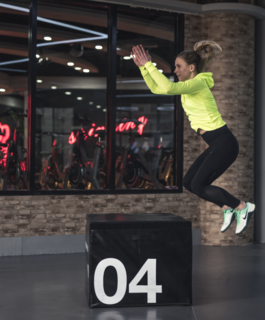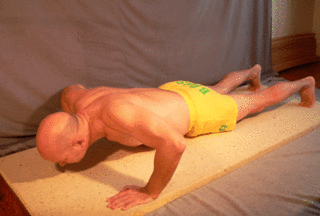 W
WStrength training or resistance training involves the performance of physical exercises which are designed to improve strength and endurance. It is often associated with the use of weights but can take a variety of different forms.
 W
WThe burpee, a squat thrust with an additional stand between reps, is a full body exercise used in strength training. The movement itself is primarily an anaerobic exercise, but when done in succession over a longer period can be utilized in as an aerobic exercise.
 W
WThe crunch is one of the most popular abdominal exercises. When performed properly, it engages all the abdominal muscles but primarily it works the rectus abdominis muscle and the obliques. It allows both building six-pack abs, and tightening the belly. Crunches use the exerciser's own body weight to tone muscle, and are recommended as a low-cost exercise that can be performed at home.
 W
WA dip is an upper-body strength exercise. Narrow, shoulder-width dips primarily train the triceps, with major synergists being the anterior deltoid, the pectoralis muscles, and the rhomboid muscles of the back. Wide arm training places additional emphasis on the pectoral muscles, similar in respect to the way a wide grip bench press would focus more on the pectorals and less on the triceps.
 W
WAn exercise machine is any machine used for physical exercise. These range from simple spring-like devices to computerized electromechanical rides to recirculating-stream swimming pools. Most exercise machines incorporate an ergometer. An ergometer is an apparatus for measuring the work a person exerts while exercising as used in training or cardiac stress tests or other medical tests.
 W
WExercise physiology is the physiology of physical exercise. It is one of the allied health professions that involves the study of the acute responses and chronic adaptations to exercise.
 W
WA gymnasium, also known as a gym, is a covered location for athletics. The word is derived from the ancient Greek gymnasium. They are commonly found in athletic and fitness centers, and as activity and learning spaces in educational institutions. "Gym" is also slang for "fitness center", which is often an area for indoor recreation. A gym may be open air as well. A gym is a place with a number of equipments and machines used by the people to do exercises.
 W
WA hyperextension or back extension is an exercise that works the lower back as well as the mid and upper back, specifically the erector spinae.
 W
WPhysical fitness is a state of health and well-being and, more specifically, the ability to perform aspects of sports, occupations and daily activities. Physical fitness is generally achieved through proper nutrition, moderate-vigorous physical exercise, and sufficient rest.
 W
WPlyometrics, also known as jump training or plyos, are exercises in which muscles exert maximum force in short intervals of time, with the goal of increasing power (speed-strength). This training focuses on learning to move from a muscle extension to a contraction in a rapid or "explosive" manner, such as in specialized repeated jumping. Plyometrics are primarily used by athletes, especially martial artists, sprinters and high jumpers, to improve performance, and are used in the fitness field to a much lesser degree.
 W
WPower training typically involves exercises which apply the maximum amount of force as fast as possible; on the basis that strength + speed = power. Jumping with weights or throwing weights are two examples of power training exercises. Regular weight training exercises such as the clean and jerk and power clean may also be considered as being power training exercises due to the explosive speed required to complete the lifts. Power training may also involve contrasting exercises such as heavy lifts and plyometrics, known as complex training, in an attempt to combine the maximal lifting exertions with dynamic movements. This combination of a high strength exercise with a high speed exercise may lead to an increased ability to apply power. Power training frequently specifically utilises two physiological processes which increase in conjunction with one another during exercise. These are deep breathing, which results in increased intra-abdominal pressure; and post-activation potentation, which is the enhanced activation of the nervous system and increased muscle fibre recruitment. Power training programmes may be shaped to increase the trainee's ability to apply power in general, to meet sports specific criteria, or both.
 W
WA push-up is a common calisthenics exercise beginning from the prone position. By raising and lowering the body using the arms, push-ups exercise the pectoral muscles, triceps, and anterior deltoids, with ancillary benefits to the rest of the deltoids, serratus anterior, coracobrachialis and the midsection as a whole. Push-ups are a basic exercise used in civilian athletic training or physical education and commonly in military physical training. They are also a common form of punishment used in the military, school sport, and some martial arts disciplines.
 W
WThe squat thrust is a calisthenic exercise. It typically is performed as follows:Bend your knees and drop into a squat position, then fall forward, placing your hands on the ground, into the push-up position. Throwing your feet back, fall forward into a push-up position. Again pull the feet forward to a squat position with hands on the floor.
 W
WThe term suspension training refers to an approach to strength training that uses a system of ropes and webbing called a "suspension trainer" to allow users to work against their own body weight.
 W
WWeight training is a common type of strength training for developing the strength and size of skeletal muscles. It utilizes the force of gravity in the form of weighted bars, dumbbells or weight stacks in order to oppose the force generated by muscle through concentric or eccentric contraction. Weight training uses a variety of specialized equipment to target specific muscle groups and types of movement.